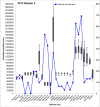Understanding marine larval dispersal in a broadcast-spawning invertebrate: A dispersal modelling approach for optimising spat collection of the Fijian black-lip pearl oyster Pinctada margaritifera
- PMID: 32555587
- PMCID: PMC7302709
- DOI: 10.1371/journal.pone.0234605
Understanding marine larval dispersal in a broadcast-spawning invertebrate: A dispersal modelling approach for optimising spat collection of the Fijian black-lip pearl oyster Pinctada margaritifera
Abstract
Fisheries and aquaculture industries worldwide remain reliant on seed supply from wild populations, with their success and sustainability dependent on consistent larval recruitment. Larval dispersal and recruitment in the marine environment are complex processes, influenced by a multitude of physical and biological factors. Biophysical modelling has increasingly been used to investigate dispersal and recruitment dynamics, for optimising management of fisheries and aquaculture resources. In the Fiji Islands, culture of the black-lip pearl oyster (Pinctada margaritifera) is almost exclusively reliant on wild-caught juvenile oysters (spat), through a national spat collection programme. This study used a simple Lagrangian particle dispersal model to investigate current-driven larval dispersal patterns, identify potential larval settlement areas and compare simulated with physical spat-fall, to inform targeted spat collection efforts. Simulations successfully identified country-wide patterns of potential larval dispersal and settlement from 2012-2015, with east-west variations between bi-annual spawning peaks and circulation associated with El Niño Southern Oscillation. Localised regions of larval aggregation were also identified and compared to physical spat-fall recorded at 28 spat collector deployment locations. Significant and positive correlations at these sites across three separate spawning seasons (r(26) = 0.435; r(26) = 0.438; r(26) = 0.428 respectively, p = 0.02), suggest high utility of the model despite its simplicity, for informing future spat collector deployment. Simulation results will further optimise black-lip pearl oyster spat collection activity in Fiji by informing targeted collector deployments, while the model provides a versatile and highly informative toolset for the fishery management and aquaculture of other marine taxa with similar life histories.
Conflict of interest statement
All authors read and approved the final manuscript, and declare that they have no competing interests.
Figures









Similar articles
-
Comparison of in situ black-lipped oyster spat collection and larval dispersal modelling results in semi-closed pearl-farming lagoons of the Tuamotu Archipelago.Mar Pollut Bull. 2024 Sep;206:116779. doi: 10.1016/j.marpolbul.2024.116779. Epub 2024 Jul 30. Mar Pollut Bull. 2024. PMID: 39083909
-
Larval dispersal modeling of pearl oyster Pinctada margaritifera following realistic environmental and biological forcing in Ahe atoll lagoon.PLoS One. 2014 Apr 16;9(4):e95050. doi: 10.1371/journal.pone.0095050. eCollection 2014. PLoS One. 2014. PMID: 24740288 Free PMC article.
-
Population Connectivity and Genetic Assessment of Exploited and Natural Populations of Pearl Oysters within a French Polynesian Atoll Lagoon.Genes (Basel). 2020 Apr 15;11(4):426. doi: 10.3390/genes11040426. Genes (Basel). 2020. PMID: 32326599 Free PMC article.
-
Larval dispersal and movement patterns of coral reef fishes, and implications for marine reserve network design.Biol Rev Camb Philos Soc. 2015 Nov;90(4):1215-47. doi: 10.1111/brv.12155. Epub 2014 Nov 25. Biol Rev Camb Philos Soc. 2015. PMID: 25423947 Review.
-
Are larvae of demersal fishes plankton or nekton?Adv Mar Biol. 2006;51:57-141. doi: 10.1016/S0065-2881(06)51002-8. Adv Mar Biol. 2006. PMID: 16905426 Review.
Cited by
-
Identifying the source populations supplying a vital economic marine species for the New Zealand aquaculture industry.Sci Rep. 2023 Jun 8;13(1):9344. doi: 10.1038/s41598-023-36224-y. Sci Rep. 2023. PMID: 37291180 Free PMC article.
-
Genetic and particle modelling approaches to assessing population connectivity in a deep sea lobster.Sci Rep. 2022 Oct 6;12(1):16783. doi: 10.1038/s41598-022-19790-5. Sci Rep. 2022. PMID: 36202873 Free PMC article.
References
-
- Nydam ML, Yanckello LM, Bialik SB, Giesbrecht KB, Nation GK, Peak JL (2017) Introgression in two species of broadcast spawning marine invertebrate. Biological Journal of the Linnean Society 120: 879–890.
-
- Pineda J, Reyns NB, Starczak VR (2009) Complexity and simplification in understanding recruitment in benthic populations. Population Ecology 51: 17–32.
-
- Gosling EM (2015) Fisheries and management of natural populations In: Gosling EM, editor. Marine Bivalve Molluscs. West Sussex, United Kingdom: Wiley Blackwell; pp. 270–324.
Publication types
MeSH terms
LinkOut - more resources
Full Text Sources

